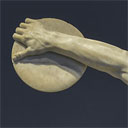0283 Collecting Classical Antiquities among the Nazi Elite
Identifiers (Article)
Abstract
Classical antiquity was appropriated by the Nazis and held up as the ideal in the rhetoric, propaganda, art, and architecture of National Socialism. In this article the rhetoric and preference for the classical aesthetic are examined against the practice of collecting antiquities among the Nazi elite, especially by Hitler and Göring. It would seem evident that Greek and Roman antiquities would have been much desired by Hitler and the upper echelons of the Nazi party and would have been sought after in the quest for great works of art for museums in the Reich, especially for the “Führermuseum” in Linz. Yet, there is only limited evidence to show that this was, in fact, the case. Insights and explanations for this discrepancy are gleaned from synthesizing the evidence for collecting classical antiquities during the Nazi era.
Statistics


License

This work is licensed under a Creative Commons Attribution-NonCommercial-NoDerivatives 4.0 International License.



